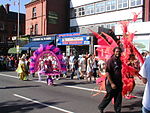Highfields, Leicester

Highfields is an inner city area of Leicester, England. It is one of the highest areas in the city, on high ground southeast of the city centre. To the west the area is bounded by the Midland Main Line, to the south by London Road (A6), and to the east by East Park Road. To the north is Spinney Hills, though there is no clear boundary between the two areas, and Spinney Hills (which extends northwards to Humberstone Road) is often considered to be part of Highfields. The neighbourhood is within walking distance of the city centre of Leicester and offers many amenities for religious, social, cultural and commercial activities. The population is split between the Spinney Hills, Wycliffe and Stoneygate wards of the Leicester City Council. A section of the area running between London Road, Evington Road and St Peter's Road was designated as the South Highfields Conservation Area in April 1981. This conservation area originally had an area of approximately 22.20 hectares. The boundaries of the conservation area were reassessed in 2003, and it was reduced to approximately 20.55 hectares.Highfields is bounded by London Road and Evington Road meaning that it has a large amount of amenities on its doorstep. Notably this includes the railway station, many Mosques (the biggest includes a leisure centre within its grounds), Churches, Temples, a modern health centre, nurseries, schools, local shops, restaurants, community centres and banks. The area also has a public library which is located on Melbourne Road.
Excerpt from the Wikipedia article Highfields, Leicester (License: CC BY-SA 3.0, Authors, Images).Highfields, Leicester
Saxby Street, Leicester Highfields
Geographical coordinates (GPS) Address Phone number Website Nearby Places Show on map
Geographical coordinates (GPS)
| Latitude | Longitude |
|---|---|
| N 52.63 ° | E -1.118 ° |
Address
Sparkenhoe Community Primary School
Saxby Street
LE2 0TD Leicester, Highfields
England, United Kingdom
Open on Google Maps








